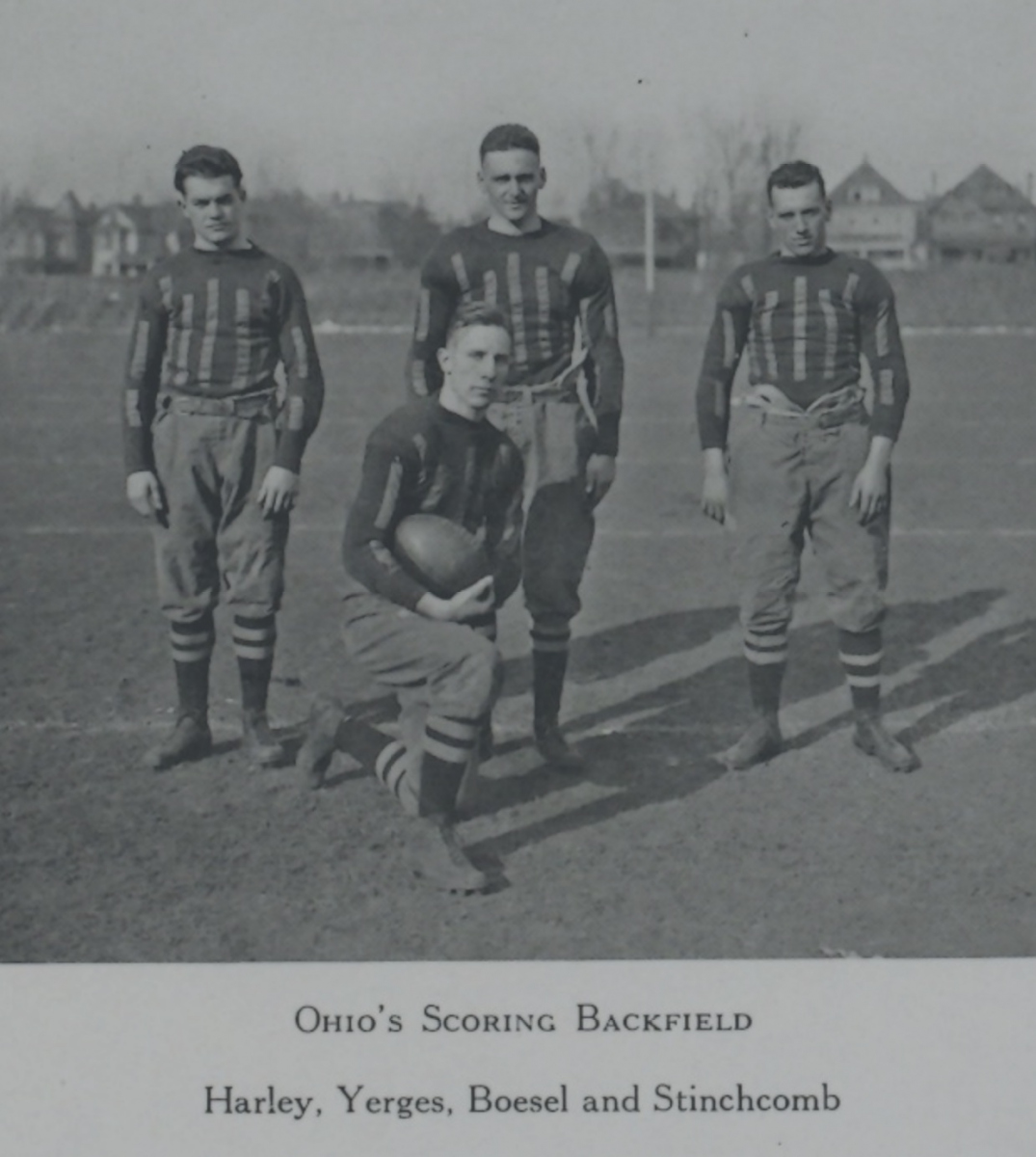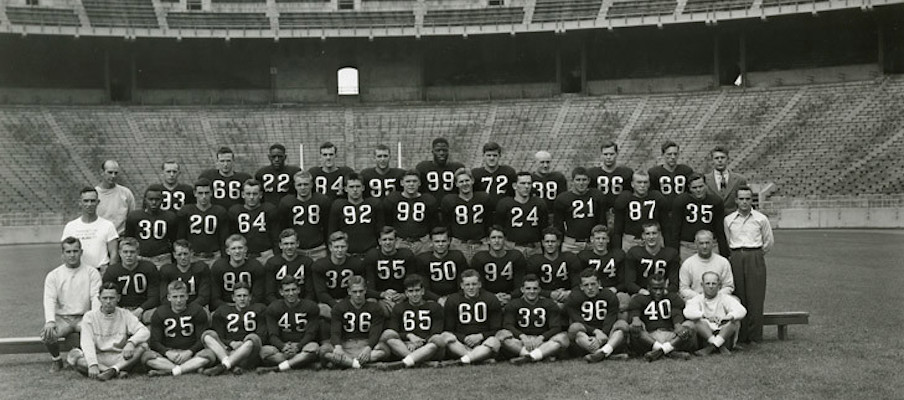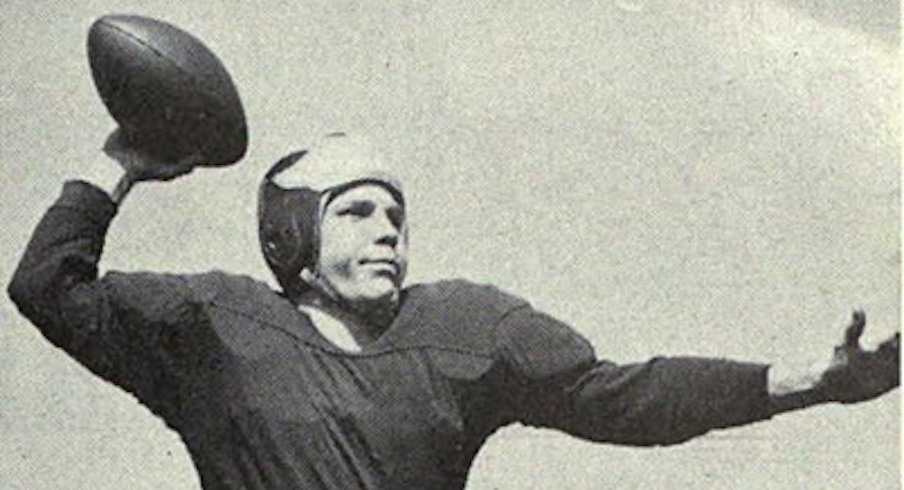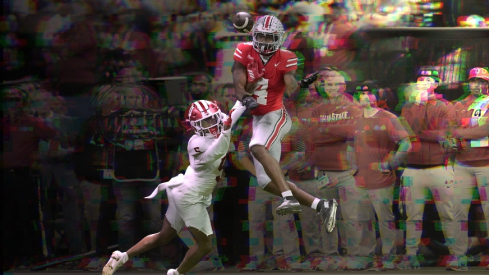In the long history of the rivalry, only a precious few individuals ever stood on one sideline dressed in scarlet and gray or maize and blue only to find themselves on the other sideline dressed in the opposite colors at some later date. The number of people who’ve played on both sides in The Game can be counted on one hand.
Only one man played quarterback for both teams.
It’s difficult to imagine that Howard F. Yerges, Jr., ever dreamed of not following his older sister Peggy to The Ohio State University. Both of their parents, Howard Sr. and Marjorie, graduated from OSU as did their aunt, Christine Yerges Conaway, who was Dean of Women when Howard Jr. enrolled there in 1943. Their uncle, Lawrence Yerges, had been a very popular student and editor of The Lantern before he was killed in the trenches in France during WWI.
Howard Sr. wasn’t your everyday graduate. He was a Buckeye legend who’d played quarterback for some of Ohio State’s greatest football squads, or to borrow a phrase from a contemporary, the “greatest scoring machine in Ohio State gridiron annals.” Although Chic Harley did most of the scoring, Howard’s heady play and leadership were critical to producing outstanding results. In his junior season in 1916, Ohio State finished the season with its first perfect record, 7-0, and outscored its opponents 258-6. The next season they won eight games, lost none and tied one while outscoring their opposition 292-6.

Ohio State’s only blemish of the 1917 season was a 0-0 draw with Auburn in Montgomery, Alabama. Some attributed the loss to the fact that Yerges did not play because he’d joined the Navy and was in Virginia receiving training with a Marine medical unit. The team lacked his leadership and strategic play.
The Auburn game was an exhibition game arranged to raise money for regiments of the Ohio National Guard who were training at Camp Sheridan. The regiments included 600 men with connections to Ohio State and combined with other units to form the 37th Infantry Division nicknamed the Buckeye Division. The 37th saw heavy fighting in the Meuse-Argonne and Ypres-Lys offensives in France and suffered 5,387 casualties including 794 men killed in action.
When Howard Jr. enrolled at Ohio State in 1943, the United States was again defending the idea of democracy with France, England and other allies. Just like when his father was there, the Buckeyes were a dominant gridiron power that only a global conflict could derail.
Ohio State captured its first national championship in 1942 under legendary head coach Paul Brown, but the war, particularly wartime restrictions, decimated the Buckeyes’ chances at defending their title. Ohio State committed to participating in the Army’s Specialized Training Program (ASTP) and this created a huge problem for Paul Brown and the Buckeyes because the Army prohibited any able-bodied, draft-eligible men from competing in varsity sports. The only men available to Brown were those who had been rejected by the Selective Service for medical reasons and given 4-F draft status or men who were too young to be eligible for the draft.
Whether he meant to or not, young Yerges found a loophole when he signed up for the Navy’s V-12 program before enrolling at Ohio State. The V-12 program was equivalent to the ASTP except the Navy felt that the gridiron fostered courage and leadership and thus was an excellent training ground for young officers, so the Navy encouraged its recruits to participate in athletics.
Due to wartime eligibility regulations, Yerges was able to suit up for Ohio State as a freshman after rules barring freshmen were suspended. He began the year listed as the third-string quarterback on the depth chart and played enough to earn a Varsity O. Ohio State stumbled through the season with a 3-6 record. Two of their six losses were against teams from naval training facilities, Iowa Pre-Flight and Great Lakes Navy, teams whose rosters were loaded with former college and NFL stars. The other four losses were to schools – Illinois, Michigan, Northwestern and Purdue – that participated in the Navy V-12 program. Ohio State beat the two ASTP schools on its schedule, Missouri and Pitt, and Indiana, a V-12 school.

Some sportswriters referred to the V-12 arrangement as college football’s Lend-Lease program. Purdue won its only Big Ten Conference championship in football in 1943. Some dubbed them the Purdue Marines because most of their roster was only on campus for five months for training purposes. Michigan, who finished the season ranked fourth in the nation, boasted 10 members from the 1942 Big Ten champion Wisconsin team, including Elroy “Crazy Legs” Hirsch.
Paul Brown felt the situation was unfair to his younger, overmatched players and he did what he could to protect them, which included playing a lot of players. The impact the ASTP had on Ohio State’s football program was a factor in Paul Brown’s decision to accept a commission with the Navy and take a leave of absence from OSU after just three seasons.
The Navy transferred Yerges to Michigan in 1944 and he earned a varsity letter as the backup to All-Big Ten quarterback Joe Ponsetto. He became the starting quarterback after a leg injury against Illinois in October sidelined Ponsetto for the remainder of the 1945 season. He led the Wolverines to victories over Minnesota and Purdue and a loss to Navy. In the final game of the season, he led U of M to a 7-3 victory over his former team. His coach Fritz Crisler said Yerges “played a whale of a game.”
He split the signal-calling responsibilities with two others for the maize and blue in 1946 and finally earned the starting job after being granted a fifth year of eligibility in 1947. Matching his father’s success at Ohio State a generation before, Yerges led the Wolverines to a perfect 10-0 season that included a Rose Bowl and a national championship crown in 1947.
The Ohio State-Michigan rivalry had been on hiatus when Yerges Sr. wore scarlet and gray moleskins. Michigan had left the Western Conference over a spat about the number of games it was allowed to schedule, so the remaining conference members were forbidden from scheduling any games with the Wolverines.
While Sr. never faced UM on the gridiron, the series was reignited soon after he left OSU when Michigan rejoined the Big Ten in 1919. Yerges Sr. returned to Ohio State as an assistant coach in 1924, spending five years on John Wilce’s staff in which the Buckeyes lost four games against the Wolverines before breaking through to snap a six-year losing streak in The Game in 1928.
Yerges Jr. played in five Ohio State-Michigan games during his playing career. He was on the losing end of his first two as a backup for Ohio State in 1943 and then for the Wolverines in 1944. Yet he notched three wins in the rivalry as Michigan’s starting quarterback in 1945, 1946 and 1947.
You can learn more about the early years of Ohio State football in the author’s book “Days of Yore: The Men of Scarlet and Gray,” which is available for purchase on Amazon. You can follow McQuigg on Twitter @dpmcquigg.


